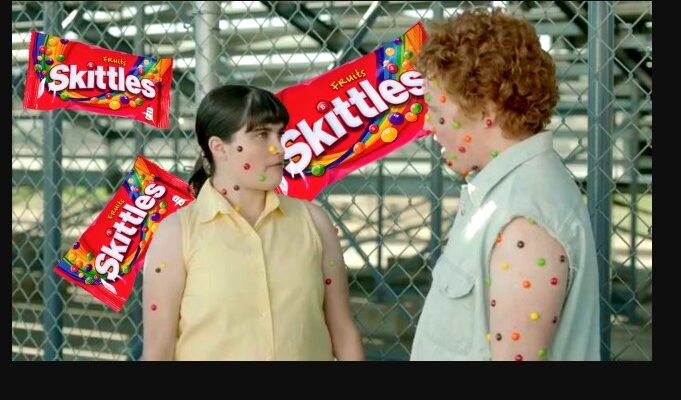Table of Contents
Introduction
Skittles, one of the most beloved candies worldwide, has recently faced a significant challenge: a ban in California.
This decision has stirred up many discussions, and it’s essential to understand the reasons behind this ban and its broader implications.
So, why did California ban Skittles, and what does it mean for consumers and the candy industry?
Background on Skittles
History of Skittles
Skittles have been a favorite treat since they were first introduced in 1974.
Known for their vibrant colors and fruity flavors, these chewy candies have captured the hearts of candy lovers everywhere.
Originally from the UK, Skittles quickly became a global phenomenon, especially after Mars, Inc. began producing them in the United States in 1982.
Ingredients Used in Skittles
The classic Skittles recipe includes sugar, corn syrup, hydrogenated palm kernel oil, citric acid, tapioca dextrin, modified corn starch, natural and artificial flavors, colors (including Yellow 5, Yellow 6, Red 40, Blue 1, and Blue 2), and a variety of other ingredients. It’s these artificial colors and certain additives that have come under scrutiny.
Reason for the Ban
Specific Ingredients Causing the Ban
California’s decision to ban Skittles centers around specific artificial colors and additives, such as Titanium Dioxide (E171). These ingredients have been linked to various health concerns, prompting lawmakers to take action. Titanium Dioxide, for instance, is used to give Skittles their bright, opaque appearance but has raised significant health concerns in recent years.
Health Concerns and Scientific Studies
Numerous studies have suggested that some artificial additives and colors used in Skittles could pose health risks, including potential carcinogenic and harmful effects. This has led health advocates and scientists to push for stricter regulations on food additives.
Legislative Actions
Key Lawmakers Involved
A led the push to ban Skittles in California A coalition of health advocates and concerned lawmakers led the push to ban Skittles in California. Key figures in this movement include State Senator [Name] and Assemblymember [Name], who have been vocal about protecting public health from potentially harmful food additives.
Timeline of the Legislative Process
The legislative process began with the bill’s introduction in early [year], followed by debates and revisions. The bill passed through various committees before finally being signed into law by the Governor in [month, year].
Public Reaction
Consumer Opinions
The public reaction to the Skittles ban has been mixed. While some consumers support the prohibition due to health concerns, others are upset about losing access to their favorite candy. Petitions and social media campaigns have emerged on both sides of the debate.
Social Media Responses
Social media has been buzzing with opinions on the Skittles ban. Hashtags like #SkittlesBan and #SaveSkittles have trended, with people sharing their thoughts and feelings about the decision. Memes, debates, and information campaigns have all played a role in shaping public opinion.
Impact on the Candy Industry
Responses from Mars, Inc.
Mars, Inc., the manufacturer of Skittles, has responded to the ban by exploring alternative formulations that comply with California’s new regulations. The company has also issued statements emphasizing its commitment to product safety and consumer satisfaction.
Changes in Production and Formulation
To continue selling Skittles in California, Mars, Inc. is considering reformulating the candy to remove the banned ingredients. This process involves significant research and development efforts to ensure the new recipe maintains the same taste and quality consumers love.
Health Implications
Potential Health Risks of Banned Ingredients
The primary health concerns associated with the banned ingredients include their potential links to cancer, behavioral issues, and other chronic health conditions. Studies have shown that long-term exposure to specific artificial colors and additives can have harmful effects, particularly in children.
Expert Opinions on the Health Impacts
Health experts generally support the ban, citing the precautionary principle. They argue that reducing exposure to potentially harmful substances is a prudent public health measure even if the risk is not definitively proven.
Comparisons to Other States
Similar Actions in Other States
California is not the first state to consider such a ban. Other states, including [State Names], have also debated similar measures, though not all have enacted them. These actions reflect a growing trend toward stricter regulation of food additives across the United States.
Differences in Regulations Across the US
Regulations on food additives vary widely across the US, leading to a patchwork of rules that can be challenging for manufacturers to navigate. Some states have stricter guidelines, while others follow federal standards set by the FDA.
Global Perspective
How Other Countries Handle Similar Ingredients
Many countries worldwide have banned or restricted the use of specific artificial colors and additives found in Skittles. The European Union, for example, has strict regulations on Titanium Dioxide and other potentially harmful substances.
International Bans and Regulations
There is a trend toward more stringent food safety regulations internationally. Countries like Canada, Australia, and New Zealand have also implemented bans or restrictions on specific additives, aligning with California’s recent decision.
Alternatives to Skittles
Other Candies Without the Banned Ingredients
Consumers looking for alternatives to Skittles can find many other candies that do not contain the banned ingredients. Brands like [Brand Names] offer similar fruity, chewy candies with natural colors and flavors.
Healthier Alternatives
For those seeking healthier options, plenty of candies are made with organic ingredients, natural sweeteners, and no artificial additives. These alternatives provide the same satisfying sweetness without the potential health risks.
Economic Impact
Effects on Local Businesses
The ban on Skittles could have economic implications for local businesses that rely on candy sales. Retailers may need to adjust their inventory and marketing strategies to accommodate the changes.
Financial Implications for Mars, Inc.
Mars, Inc. may face financial challenges due to the need for reformulation and potential sales loss. Still, the company will likely adapt and find new ways to meet consumer demand while complying with the latest regulations.
Future of Skittles in California
Possible Reformulations
Mars, Inc. is actively working on reformulating Skittles to remove the banned ingredients. These new versions of Skittles could soon be available in California, offering a safe and compliant option for consumers.
Legal Appeals and Future Legislative Actions
While the current ban is in place, legal appeals or future legislative actions could alter the landscape. Lawmakers and industry leaders will continue negotiating the best path forward for public health and business interests.
Consumer Guidance
How to Identify Harmful Ingredients
Consumers can protect themselves by reading labels carefully and being aware of harmful ingredients. Look for natural colors and flavors, and avoid products with a long list of artificial additives.
Tips for Making Healthier Candy Choices
When choosing candies, opt for products with simple, recognizable ingredients. Organic and natural candies are often better, as they avoid artificial additives and preservatives.
Conclusion
The ban on Skittles in California marks a significant shift in the approach to food safety and consumer health.
While it has sparked debate and controversy, the underlying goal is to protect public health from potentially harmful ingredients.
As the candy industry adapts, consumers can look forward to safer, healthier options that still deliver the sweet satisfaction they crave.





